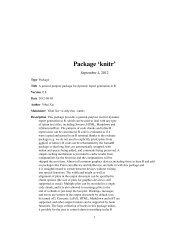Package 'openair'
Package 'openair'
Package 'openair'
You also want an ePaper? Increase the reach of your titles
YUMPU automatically turns print PDFs into web optimized ePapers that Google loves.
98 rollingMeanExamples#example 1##see axis formatting in an openair plot, e.g.:scatterPlot(mydata, x = "no2", y = "pm10")#example 2##using quickText in other plotsplot(mydata$no2, mydata$pm10, xlab = quickText("my no2 label"),ylab = quickText("pm10 [ ug.m-3 ]"))rollingMeanCalculate rollingMean valuesDescriptionCalculate rollingMean values taking account of data capture thresholdsUsagerollingMean(mydata, pollutant = "o3", hours = 8,new.name = "rolling", data.thresh = 75)ArgumentsmydatapollutantA data frame containing a date field.The name of a pollutant e.g. pollutant = "o3".hours The averaging period to use e.g. hours = 8 will generate 8-hour rollingMeanvalues.new.namedata.threshThe name given to the new rollingMean variable. If not supplied it will create aname based on the name of the pollutant and the averaging period used.The data capture threshold in values are calculated if data capture over theperiod of interest is less than this value. For example, with hours = 8 anddata.thresh = 75 at least 6 hours are required to calculate the mean, else NAis returned.DetailsThis is a utility function mostly designed to calculate rolling mean statistics relevent to some pollutantlimits e.g. 8 hour rolling means for ozone and 24 hour rollingMeans for PM10.Author(s)David Carslaw
















